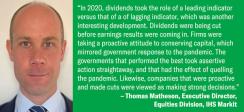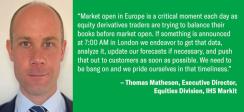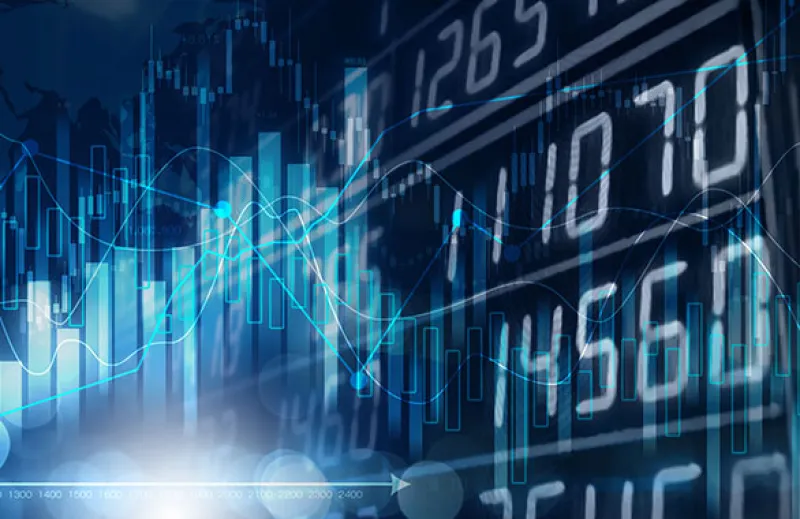Dividends can provide a crucial starting point upon which returns are built, but equity analysts often give them short shrift or treat them as an afterthought. When used as a starting point rather than viewed as a byproduct, dividends can be analyzed for turning points in the performance of company.
Thomas Matheson is an Executive Director within the Equities division at IHS Markit, where he heads a dividend research team of nearly 40 global equity analysts that issues dividend forecasts. Conducting bottom-up corporate financial statement analysis, the team forecasts amounts and dates of dividends, because the timing of allocation shifts can be equally important to the amounts. Across the universe of its forecasts, the team also provides commentary and forecast notes, so clients can gain more color into whether they agree with the forecast, whether they want more data, and whether they want to reach out to the team – something Matheson encourages.
II recently spoke with Matheson, whose team conducts independent research on dividend amount and date estimates for over 28,000 stocks, ADRs, and ETFs globally.
What does a company’s ability to pay dividends tell investors beyond speaking to solid fundamentals?
Thomas Matheson: They do demonstrate strong fundamentals, but there’s also a human aspect to a board’s propensity to pay dividends, and those two angles make them difficult to predict. Typically, it’s seen as a good indicator of future prospects if the board is willing to increase its dividend. It shows confidence and provides transparent evidence that the board is serious about its capital allocation discipline. There is plenty of research that supports the idea that over time firms that pay dividends tend to outperform the general market.
In fact, dividends are such a transparent indicator of strong governance that it’s interesting to consider how they might be incorporated into ESG data and evaluation. The fact that a company consistently pays dividends over time indicates strong governance and could perhaps be tied in with some traditional ESG indicators to create a composite score that investors could consider. We are looking closely at how to do that.
You and your team have an optimistic outlook for dividends. What do you base that on?
Matheson: We feel the global economic recovery is underway. We arrive at our estimate by aggregating our bottom-up analysis for the stocks that we forecast, and then apply that across markets globally. The growth we’re anticipating this year is a function of the changes across regions. In fact, the pandemic has been an accelerant in the polarization of dividends across different regions. For example, strong upward trends that had been going on for a number of years in U.S. dividends managed to maintain fairly flat last year. In Europe, dividends have been struggling for some time, and last year they absolutely crashed, with over half of European firms cutting payments. And Asia performed much stronger, especially mainland China which saw its economic recovery come in sooner – and we’re expecting further growth in mainland China this year.

What about at the sector level this year?
Matheson: We’re expecting big growth in the banking and insurance sectors relative to last year. Both were particularly hard hit by pandemic regulators forcing firms to not pay dividends. As that regulation eases, we’re seeing a rebound – although we don’t expect dividends in these two sectors to reach the levels seen in 2019.
Was that regulatory pressure felt equally by banks and insurers around the world?
Matheson: The regulatory response was most severe in Europe, while U.S. banks didn’t have the same pressure. In Asia the response was mixed. For example, Australia followed something along the lines of the European model. Overall, in markets where there was a severe political and regulatory response banks and insurers tended to be hit hard due to the view that capital needed to be conserved so it could be lent out to feed the recovery.
Did the pandemic pull back the curtain on some unintended risks taken on by asset managers who rely on in-house dividend estimates?
Matheson: The most interesting thing about the changes we saw to dividends last year was that big dividend changes weren’t a byproduct solely of company performance. Rather, as I just mentioned, exogenous factors and political and regulatory pressure were causing dividends to be cut. In Europe, roughly over half of firms cut dividends. Globally, we calculated $350 billion was cut or canceled in dividend payments last year – very big numbers. In a scenario like that, where payments were being cut because of non-fundamental reasons, it is even harder for an asset manager to keep track of the changes.
In 2020, dividends took the role of a leading indicator versus that of a of lagging indicator, which was another interesting development. Dividends were being cut before earnings results were coming in. Firms were taking a proactive attitude to conserving capital, which mirrored government response to the pandemic. The governments that performed the best took assertive action straightaway, and that had the effect of quelling the pandemic. Likewise, companies that were proactive and made cuts were viewed as making strong decisions. We were seeing differences even within Europe – insurers in Germany versus the UK versus Switzerland all behaving differently because of their own market regulators. Social distancing measures meant AGMs were cancelled and dividends couldn’t be paid. Like many other things, our forecasting framework needed to adapt and our analysts added regulatory reports and corporate bylaws to their investigations. If you don’t have the resources and ability to zoom in on dividends, it’s very easy to miss things or perhaps make assumptions and miscalculate on income projections. In a period of dramatic volatility having an independent benchmark to act as a verification becomes even more crucial. If you’re carrying dividend risk, having the most accurate forecast is essential to your strategy.
You’re rolling out some enhancements that will greatly improve the user experience for asset managers on your platform. Tell us about those.
Matheson: The enhancements focus on the portfolio section, specifically the ability for users to enter their own portfolio and track changes. When users receive our market-leading data in near to real time, the updates are very fast and easy to consume – as has been the case – but now they can customize the data flow across their portfolio and gain insights into where the risks might be at single stock, index, or portfolio level.
The enhancements also highlight visualizations, especially around our confidence scores that provide an easy way of gaining deeper insight into how accurate we think our forecast will be. Some dividends are very stable and unlikely to change while others are very volatile or difficult to predict. We have a scoring system that allows users to identify where this dividend risk might be, and they can look across this and screen their portfolios to see what dividends they can expect in a particular period and where the dividend risk is going to be. We also provide ad hoc scenario analysis outlining risk and are launching a proprietary dividend drop score, which calculates the probability of a dividend cut for a specific firm.
You mentioned near to real time data flow earlier. How frequently are users seeing data updates?
Matheson: We have a team of analysts making updates throughout the day, and those flow into the portal within a minute or two. It’s very quick. Some users might check updates every hour or two. Market open in Europe is a critical moment each day as equity derivatives traders are trying to balance their books before market open. If something is announced at 7:00 AM in London we endeavor to get that data, analyze it, update our forecasts if necessary, and push that out to customers as soon as possible. We need to be bang on and we pride ourselves in that timeliness.

Is everything we’ve been discussing part of a solution set for asset managers?
Matheson: Yes. Our data is available via several different methods. Our largest users take it in API and flat file, and also use the web portal to check updates. Along with the dividend forecasting on the web portal, we also have ETFs and index benchmark services available. What that means is, for example, when the equity derivatives traders I just mentioned want dividend data and index and ETF composition data, it’s all available via one platform. We have enhanced custom baskets functionality that users can plug in to that as well. In addition, we have dividend forecasting data available via thinkFolio, which is IHS Markit’s portfolio management system for the buy-side front office, as well as IHS Markit’s Data Lake which includes over 1,500 of our data sets across multiple industries.
When you were talking about in-house dividends forecasting, you mentioned that many of your asset manager clients have in-house teams and use IHS Markit’s capabilities and tools as well. What do they gain by having your team in the mix?
Matheson: We have forecast history for over 10 years, which is unique within the industry. That’s a huge benefit as more and more quant-like buy-side firms are looking at how they can use dividend data as an investment signal. They need historical data to test their strategies.
We’re also trusted by many of the derivatives’ exchanges for their end-of-day pricing models, and that’s validation of the quality of the data and analysis we do. Additionally, we work with index providers, looking at smart beta strategies and how to use dividend forecasting to enhance their offerings. And we genuinely pride ourselves on superb customer service. We’ve been working together with these firms for such a long time that we’ve learned what they need and when we can proactively respond to them. We reach out to them with updates and research notes on areas we know they’re interested in, and they have access to our team. For example, if we were asked about a particular forecast by a customer and then we change it, the analyst making the update will reach out to that customer and let them know – so, it’s not an anonymous client services team, it’s the person making the forecast speaking to the client.
I should mention, too, that along with looking at dividends from a fundamental viewpoint we also have output from the options market, so we can look at implied dividends and marry up the options output. Additionally, we leverage data from our securities finance team to see what stocks are being shorted, as well as our Purchasing Managers’ Index (PMI) data for insight on the global economy. Combining all these different inputs allows us to see the big picture, and as we expand the model, it allows our clients to take the broadest possible or most niche view.
On that quant angle you mentioned, has that changed the makeup of your team at all?
Matheson: As we’ve observed customers on the buy-side looking to extract investment signals we’ve expanded our team to include data scientists and look at how dividends can impact share prices. We’ve used our forecast history to back-test dividend forecast portfolios, and observed they typically exhibit higher returns with lower volatility than relying on trailing dividend data. We’ve also built an advanced analytics model to replicate our analysis and trusted methodology, enabling us to expand the universe that we forecast for – it’s the sort of beachhead from which we can launch more analytics and more interesting scores that we’ll make available via this portal in the years to come.
Learn more about how to turn dividends into a starting point for your investment strategies.






